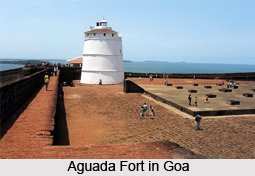 After the arrival of the Holy Office in Goa in 1560 the Viceroy gave them the old palace of Yusuf Adil Shah. He also shifted his own accommodations to the fortress and with the prospect of so many souls in mortal peril; they initiated their actions with much zeal and enthusiasm. The means used to save the souls of the unnumbered accused who passed through these portals all too often destroyed the rather more frail bodies which temporarily housed them. This however did not discourage the Inquisitors who and after every two or three years crowned their efforts with an auto-da-fe. During this beautiful ceremony, which was normally celebrated for two days one day was kept for the sentencing and one day was spent for the executions. The Church, with its terrifying majesty, along with it`s vice regal secular arm meet different people with a spectacle of total unity. The Church and State had their strong determination to prevent any deviations from the rules imposed by them and also to impose their beliefs. Seldom has a total conviction been accompanied with such lack of understanding that these actions might come to disagreement with the creed preached and could have the effect of turning people against that creed rather than causing them to accept it.
After the arrival of the Holy Office in Goa in 1560 the Viceroy gave them the old palace of Yusuf Adil Shah. He also shifted his own accommodations to the fortress and with the prospect of so many souls in mortal peril; they initiated their actions with much zeal and enthusiasm. The means used to save the souls of the unnumbered accused who passed through these portals all too often destroyed the rather more frail bodies which temporarily housed them. This however did not discourage the Inquisitors who and after every two or three years crowned their efforts with an auto-da-fe. During this beautiful ceremony, which was normally celebrated for two days one day was kept for the sentencing and one day was spent for the executions. The Church, with its terrifying majesty, along with it`s vice regal secular arm meet different people with a spectacle of total unity. The Church and State had their strong determination to prevent any deviations from the rules imposed by them and also to impose their beliefs. Seldom has a total conviction been accompanied with such lack of understanding that these actions might come to disagreement with the creed preached and could have the effect of turning people against that creed rather than causing them to accept it.
The Holy Office handled sufficiently to keep Goa itself in a state of dogmatic purity for the following two hundred years. It was finally abolished in 1774. For its bizarre form of administration its authority did not extend beyond the frontiers. It did not even extend upto the realm of foreign negotiations because sometimes the state only seemed to survive by hazardously harmonizing one alliance against another and none of them with their fellow Catholics. The narrow standards of the Inquisition were not universally supported by all the clergy particularly the Jesuits who soon earned and developed the status for urbanity which has gripped them ever since.
This article is a stub. You can enrich by adding more information to it. Send your Write Up to content@indianetzone.com



















